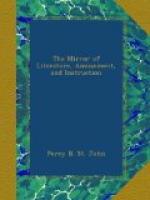BLARNEY CASTLE.
[Illustration: Blarney Castle.]
This Engraving, to use a cant phrase, is an exquisite “bit of Blarney;” but independent of the vulgar association, it has a multitude of attractions for every reader. Its interest will, however, be materially enhanced by the following admirable description from the graphic pen of T. Crofton Croker, Esq.[1]
[1] Researches in the South
of Ireland, Illustrative of the Scenery,
Architectural
Remains, and the Manners and Superstitions of the
Peasantry.
By T. Crofton Croker. 4to. 1824 Murray. Vol.
XIV.
Blarney, so famous in Irish song and story, is situated about four miles north west of Cork, and was, within these few years, a thriving manufacturing village; but it no longer wears the aspect of comfort or of business, and appears much gone to decay.
The alteration struck me very forcibly. In 1815, I remember a large square of neat cottages, and the area, a green shaded by fine old trees. Most of the cottages are now roofless; the trees have been cut down, and on my last visit, in 1821, a crop of barley was ripening in the square.
“the
clam’rous rooks
Ask for their wonted seat, but ask in
vain!
Their ancient home is
level’d with the earth,
Never to wave again its leafy head,
Or yield a covert to
the feather’d choir,
Who now, with broken song, remote and
shy,
Seek other bowers, their
native branches gone!”
This prepared me to expect a similar change in the grounds of the castle, where much timber has been also felled; but the grounds still are beautiful, rock and water being features in the landscape, the picturesque effect of which neglect cannot injure.
The castle consists of a massive square tower, that rises broad and boldly above surrounding trees, on a precipitous rock over a stream called the Awmartin; and attached to the east side is an extensive dwelling-house, erected about a century since by Sir James Jeffreys, who purchased or obtained this estate from the crown, and in whose family it still continues.
Blarney Castle was built about the middle of the fifteenth century, by Cormac MacCarty, or Carthy surnamed Laider, or the Strong. He was descended from the kings of Cork, and was esteemed so powerful a chieftain that the English settlers in his part of Munster paid him an annual tribute of forty pounds to protect them from the attacks and insults of the Irish. To him is also ascribed the building of the Abbey and Castle of Kilcrea, the Nunnery of Ballyvacadine, and many other religious houses; in the former of which he was buried.[2] It would be a matter of little importance and considerable labour to trace the Castle of Blarney from one possessor to another. The genealogical table in Keating’s “History of Ireland” will enable those addicted to research




